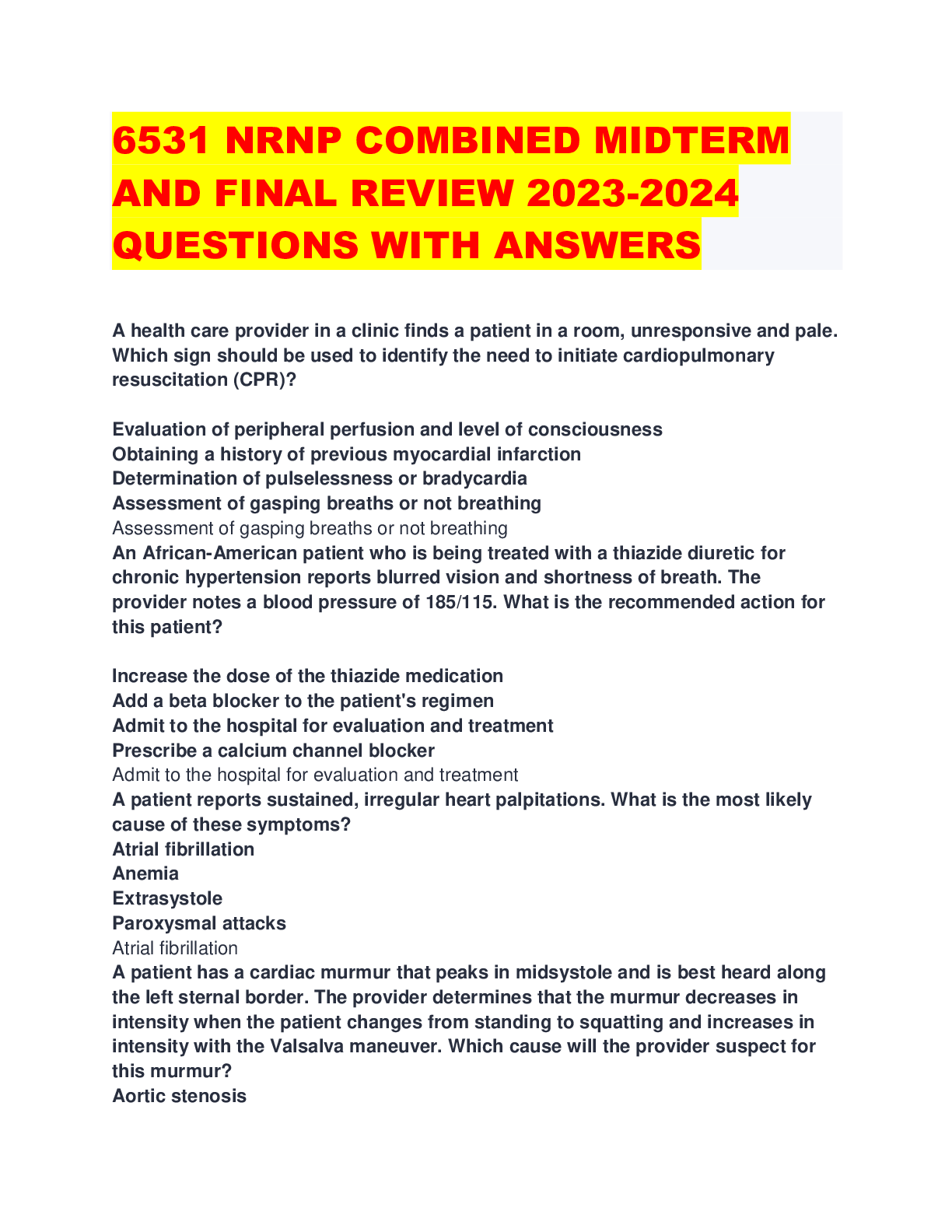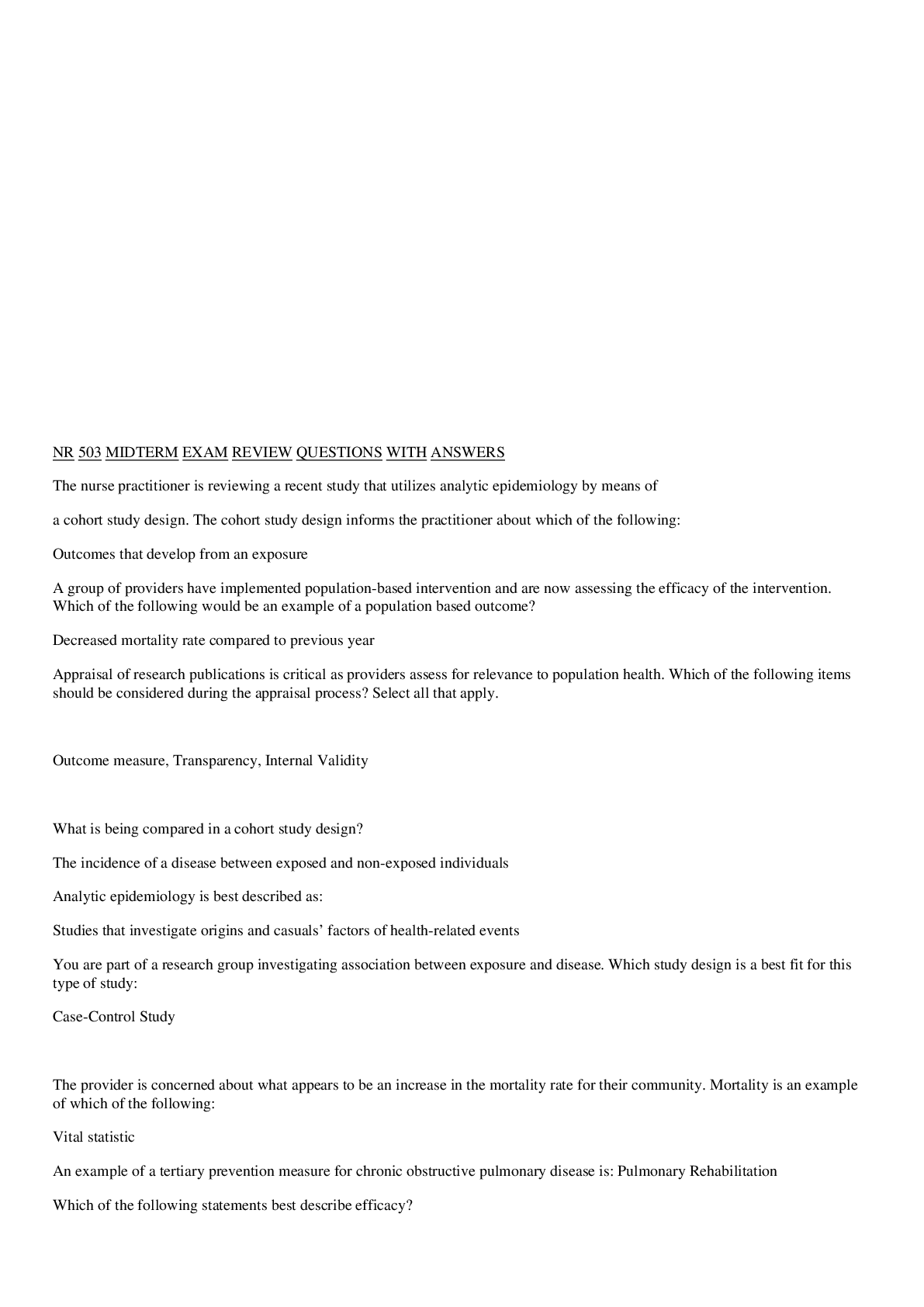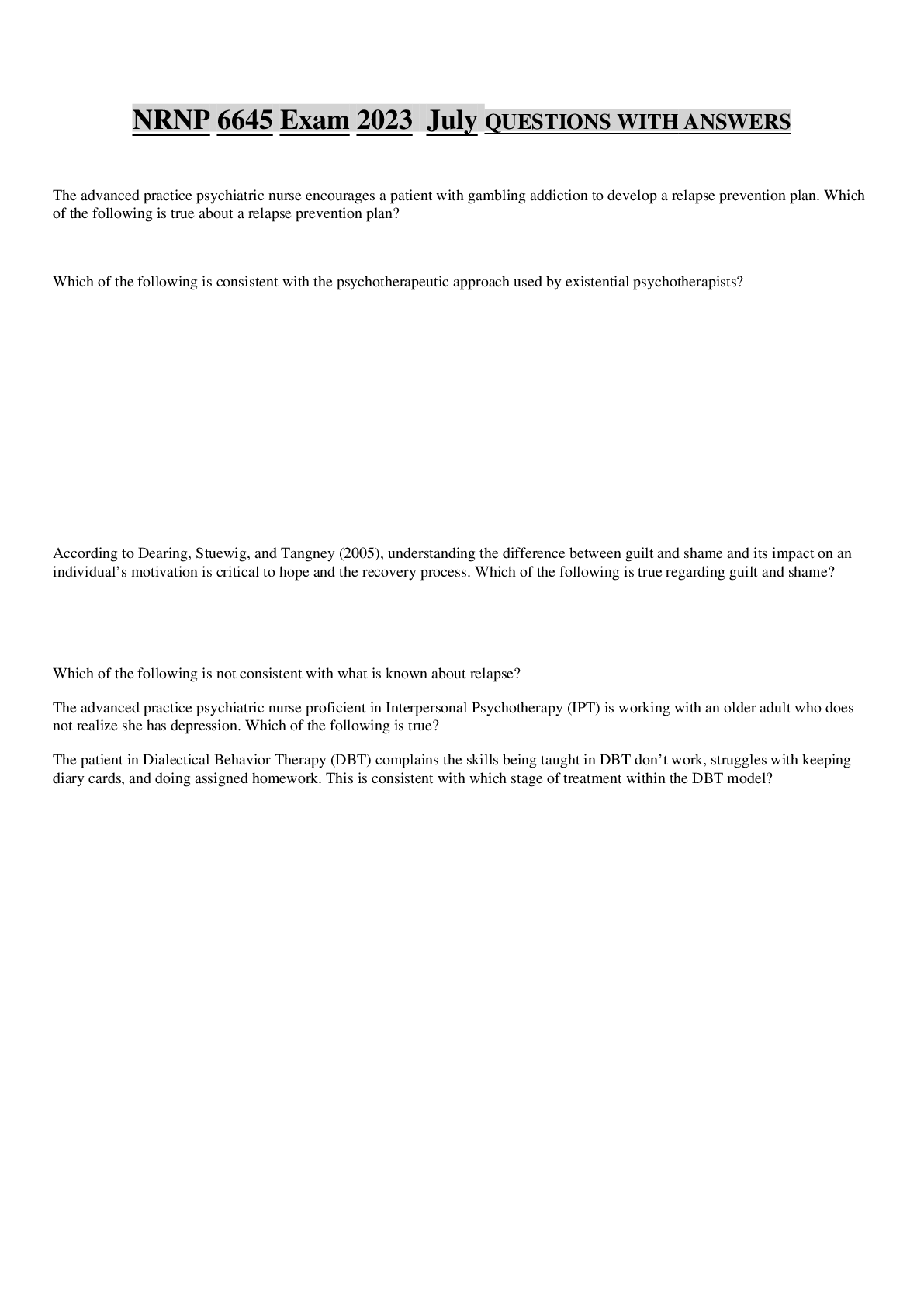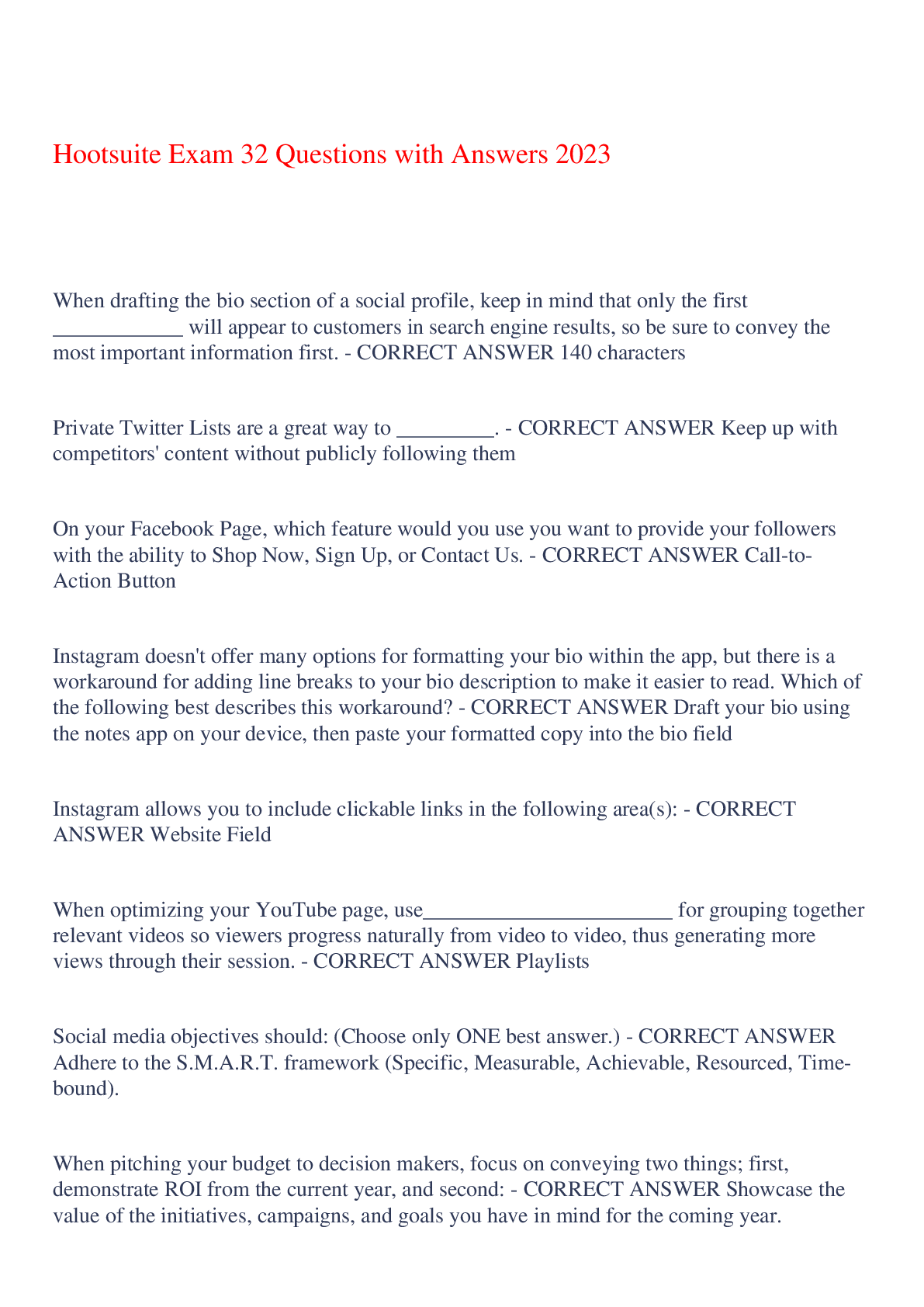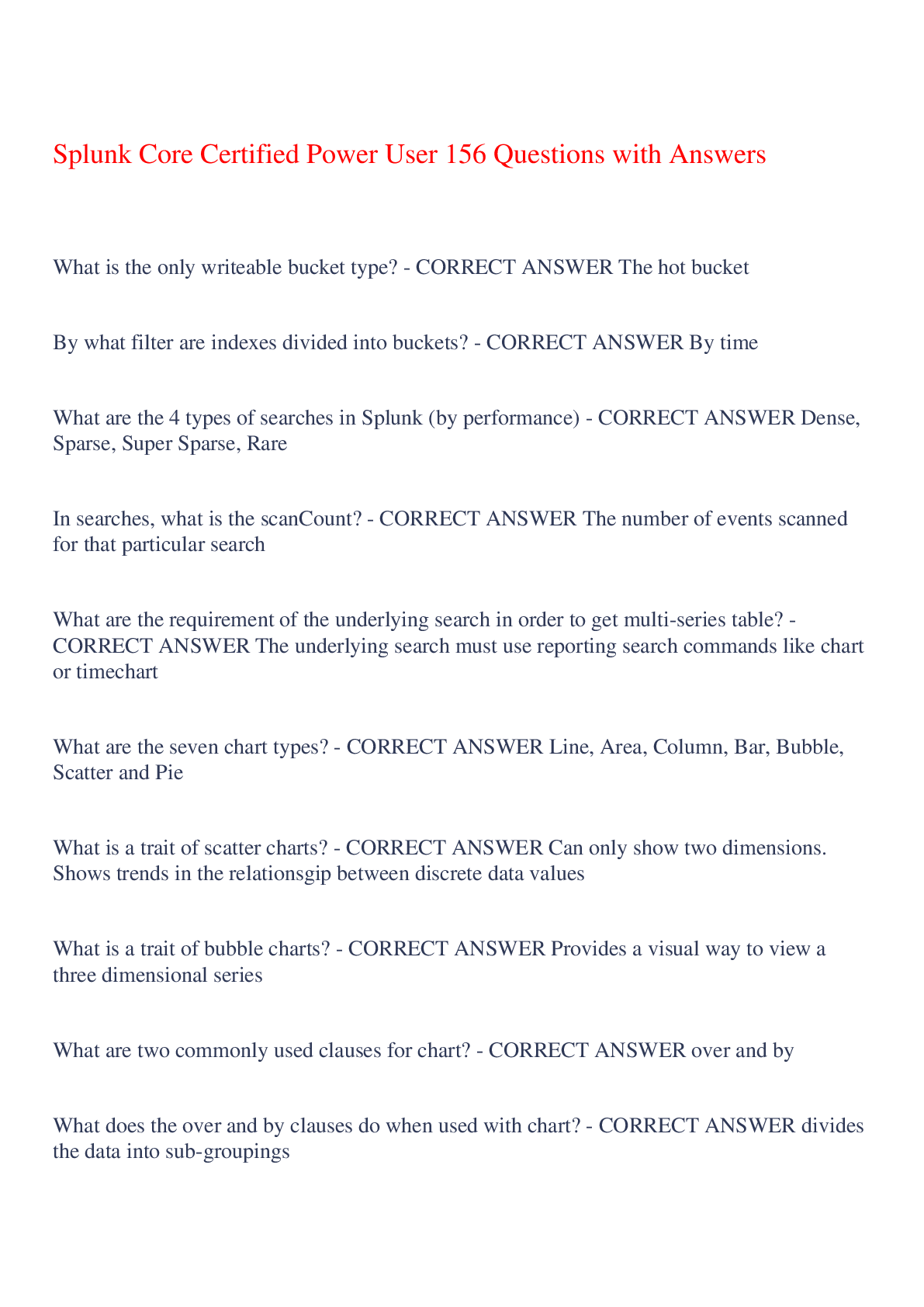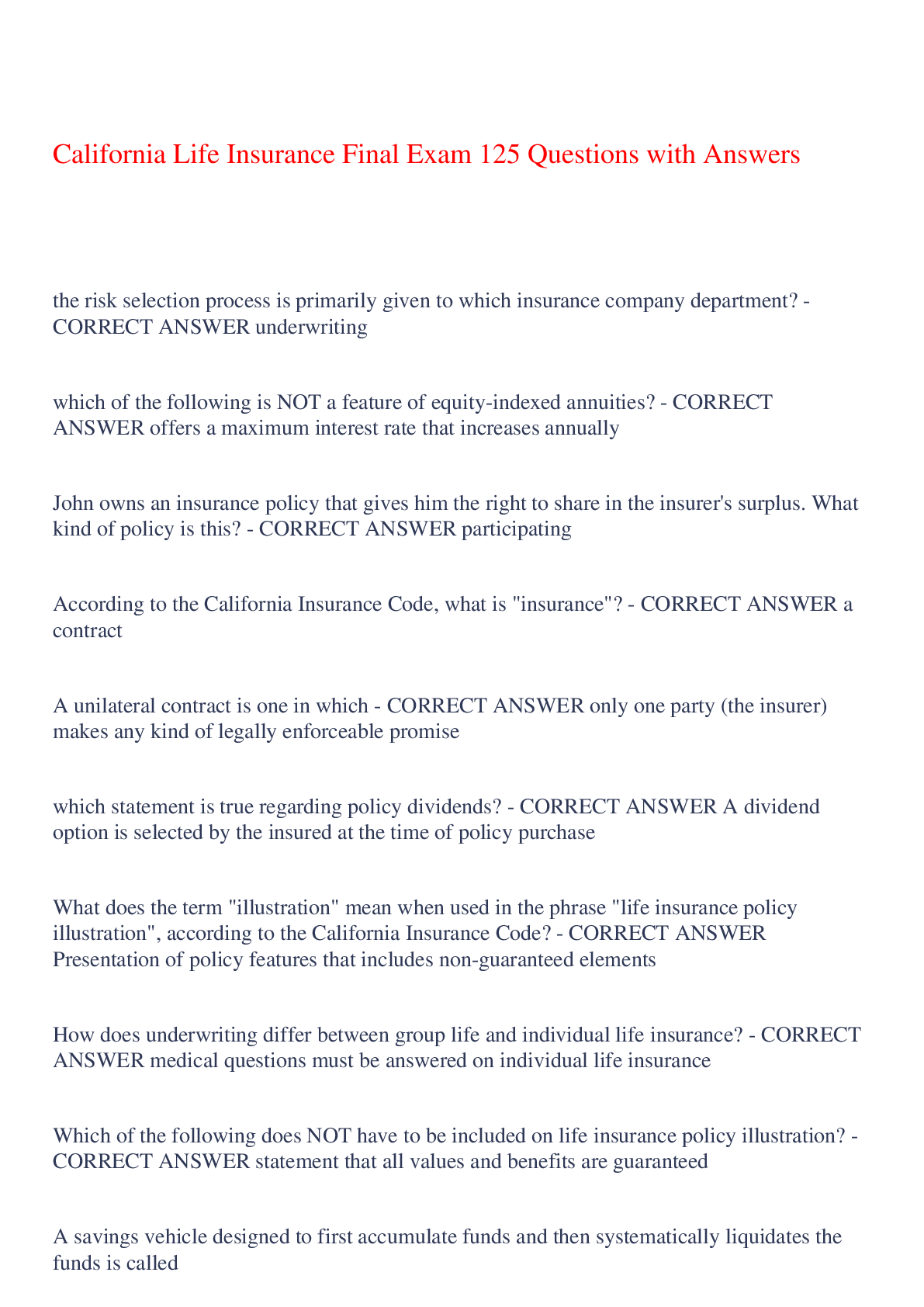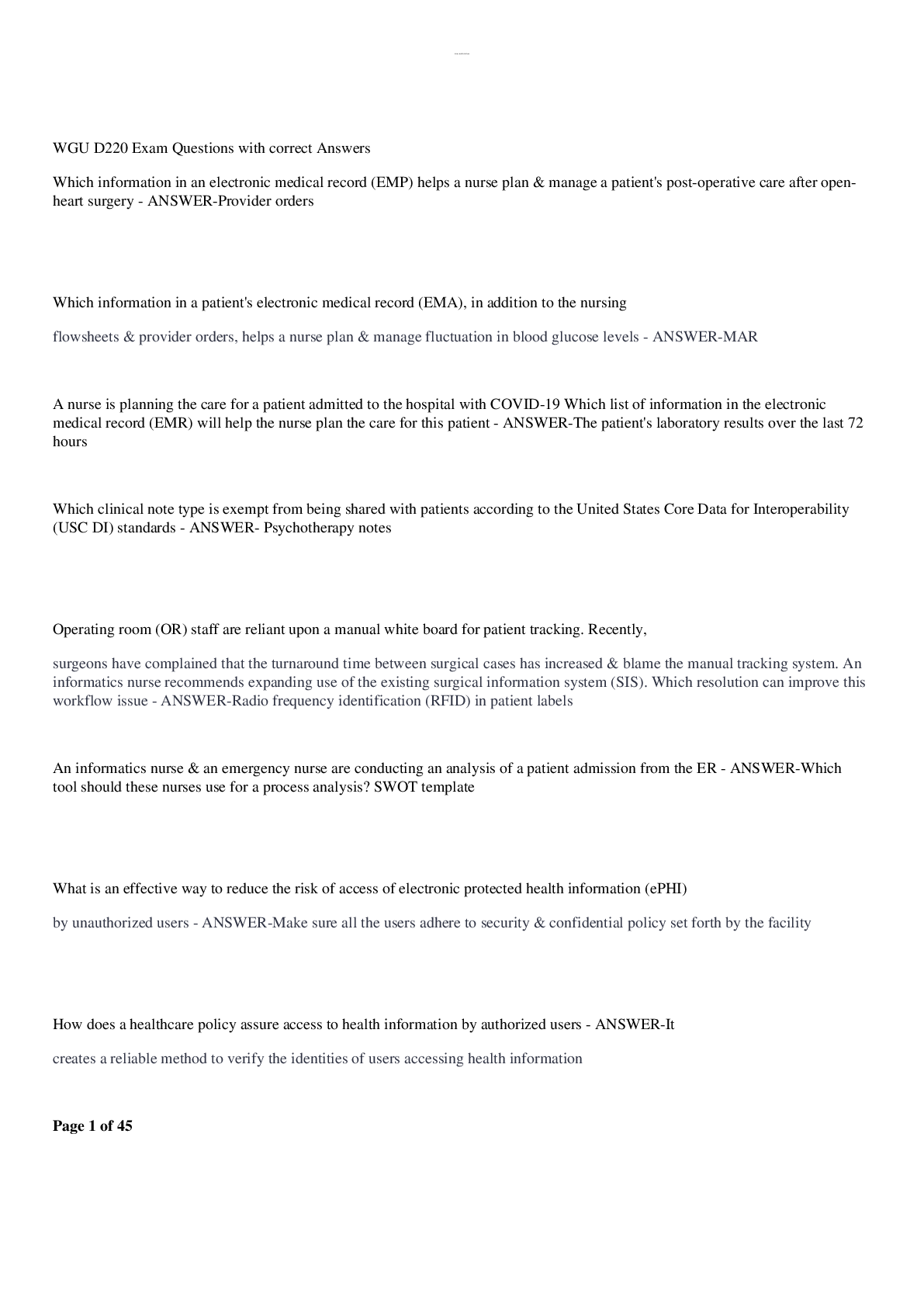Health Care > EXAM > EDU 200 Final Exam 87 Questions with Answers 2023,100% CORRECT (All)
EDU 200 Final Exam 87 Questions with Answers 2023,100% CORRECT
Document Content and Description Below
EDU 200 Final Exam 87 Questions with Answers 2023 statistical learning. - CORRECT ANSWERwhen our brains unconsciously "pickup" on the regularities in our environment. & we use them to know how to... act / what to expect. Conditioning - CORRECT ANSWERthe process of learning associations between environmental events and behavioral responses (2 stimuli - changes in the environment) classical conditioning - CORRECT ANSWERa learning process that occurs when two stimuli are repeatedly paired John Watson. What are 2 stimuli & effect? - CORRECT ANSWERLittle Albert, show animal then make loud noise = fear of animals. - Loud noise = natural stimulus - Rat (animal) = conditioning = fear of rats / fluffy / white animals What is the process of classical conditioning? 5 steps - CORRECT ANSWER1. US elicits UR 2. Neutral Stimulus (NR) does NOT elicit US 3. NS is repeatedly paired with US 4. NS becomes Conditioned stimulus (CS) 5. CS elicits CR (conditioned response) Palov's Dogs - CORRECT ANSWERrecorded high levels of salivation when flashed light then given meet (condt) & when hearing squeaky shoes (stat learning) operant conditioning - CORRECT ANSWERChanging behavior through consequences positive reinforcement. negative reinforcement. positive punishment negative punishment - CORRECT ANSWER- giving something pleasant connected to appropriate behavior. - taking away annoying stimulus in connection w/ appropriate behavior - giving something annoying in connection w/ inappropriate behavior - take desirable away in connection w/ inappropriate behavior. B.F. Skinner - CORRECT ANSWERdeveloped the theory of operant conditioning by training pigeons and rats concept. Can concepts change? - CORRECT ANSWERA mental grouping of similar objects or ideas Yes can change depending on context types of categories? - CORRECT ANSWERsurface - Based on similarities that are easy to see, hear, touch, etc. Rational - similarities based on deeper connections like goals, purposes, and attitudes, mechanisms or functions Rational Shift. - CORRECT ANSWERlearning about a topic & first focus on surface similarity & slowly get better at seeing relational similarities. Analogical Reasoning Why important? - CORRECT ANSWERWhen we use a specific structure to make sense of new information Structural mappings are important for learning & expert thinking Analogy How do you get an analogy Mapping can be... - CORRECT ANSWERmappings of similarities between concepts EX: Dog = puppy Cat= kitten must know base to connect target Surface or rational Piaget's adaptation - CORRECT ANSWERAccommodation / assimilation Learners adapt their concepts to their environment via assimilation or accommodation in order to receive equilibrium & stay outta disequilibrium. Adaptation - CORRECT ANSWERWe slowly adapt our concepts (the way we see the world) to fit the world we experience. The weakest concepts are discarded over time. Schema ex: Importance? - CORRECT ANSWERPiaget's way of saying basic building blocks of intelligent behavior - way we organize knowledge (CONCEPT) EX: food thats good, opinions of me, parenting importance = shows us how to act Assimilation Accommodation Equilibrium Disequilibrium Equilibration - CORRECT ANSWER- A new exp is largely consistent w/ an existing schema - Changing extensively an old schema to fit new experience - When the schema is in balance w/ your experience - When the environment presents you w/ info that doesn't fit in your current schema e - Process of getting to equilibrium Motivation - CORRECT ANSWERA force or state that initiates,energizes, directs and sustains our actions intristic motivation vs extrinsic motivation - CORRECT ANSWERI: motivation bc its enjoyable, interesting, meaningful & worthwhile E: motivation via expectation of external rewards self-determination theory - CORRECT ANSWERtheory of motivation concerned w/ the beneficial effects of intrinsic motivation and the harmful effects of extrinsic motivation What are the 3 basic needs to be met with this theory? - CORRECT ANSWER1) Autonomy - being able to make choices & feel in control 2) Competence - Feeling capable of success over time 3) Relatedness - perception of connectedness, caring or belonging Expectancy x Value = ? Def? How do students learn more? - CORRECT ANSWEREffort Expectancy - Expectation of success in a given task. Value - seeing the task as useful or interesting. - when they're motivated intrinsically, value the task, and expect to do well. Learned Helplessness - CORRECT ANSWERLow expectations & Daunting tasks Incremental (Mastery/ Growth) Mindset Entity (Fixed) Mindset - CORRECT ANSWER- Ability is subject to change. Effort determines ability. - Ability is a stable characteristic. Talent or birthright determines ability. Neural Plasticity - CORRECT ANSWERchanging nature of the brain, rewire connectionAbility to recover after stroke resilience - CORRECT ANSWERthe ability to adapt effectively in the face of threats Brain Placticity - CORRECT ANSWERthe brain's ability to change throughout life. environmentally driven pruning & we loose what? - CORRECT ANSWERthe process of eliminating unused synapses we lose some plasticity to learn as we age but never all of it. Adaptive Change Maladaptive Change - CORRECT ANSWER- anything in the brain that leads to a positive outcome - anything that leads to harmful dangerous outcomes What is brain change? What are the three mechanisms by which experience can cause change in the brain? - CORRECT ANSWERthe process of learning Anatomic Neurochemical Metabolic anatomical change - CORRECT ANSWERSomething physically changes in the brain. This could be new brain cells, neural connections, dendritic growth, or a concussion. neurochemical change - CORRECT ANSWERAn existing synapse increases or decreases the amount of chemicals (hormones,adreneline, etc.) that are received by neurotransmitters. This can either increase or decrease the learning process, how we feel, how quickly we can remember etc. metabolic change - CORRECT ANSWERIncrease or decrease in the amount of glucose and oxygen available or used in the brain. information processing theory - CORRECT ANSWERtheory proposing that human cognition consists of mental hardware and mental software Sensory memory Working memory Long term memory - CORRECT ANSWER- The brief storage (in memory) of information experienced by the senses; typically only lasts up to a few seconds. - keep a limited amount of information available long enough to use it. Working memory helps process thoughts and plans, as well as carries out ideas. - memories that range from a few days to decades embodied cognition Types of Embodiment Theory - CORRECT ANSWERour bodies and memories work together in order to be more efficient. Repreception, Meshing, Suppression Repreception Meshing Suppression - CORRECT ANSWER- memories are constructed of what we perceive- our experiences. - our memories help us make sense of what we are perceiving - we want to remember something we were not currently experiencing. blocking your environment to help you remember. Rote learning Shallow learning Deep learning - CORRECT ANSWER- learning w/ out meaning - meaning but lack of connection (ex: mem def, math formulas, spelling) - Making connections (ex: expert knowledge, big picture explained) What are 5 Pedagogical Principles to Encourage Mental Engagement so that students develop Deep Knowledge? - CORRECT ANSWER1) Anticipate what your lesson will lead students to think about 2) Use discovery learning carefully 3) Design reading assignments that require students to actively process the text 4) Design lessons so that students can't avoid thinking about the lesson's goal 5) Design tests that lead students to think about and integrate the most important material learning history Ex? - CORRECT ANSWERthe sum of everything you have ever learned through any mechanism. Ex: Driving to supermarket but end up at school Disadvantages of Learning history - CORRECT ANSWERCan hinder next learning situation can lead to misconceptions & errors bc the learner often will not stop & think abt what they retrieve automatically to see if it correctly applies to a new learning situation. Multicausality Ex & Study done? - CORRECT ANSWERall behavior is created by many interacting factors not one dominant controlling factor. ex: Bad behavior caused by age, environment, parenting, neighborhood (A lot of things) A not B study Vygostky - CORRECT ANSWER- Socio-Cultural Learning Model - Use of and Internalization of Cultural Tools - Zone of Proximal Development - Scaffolding what are some Cultural tools (4) 3 steps of internalizing cultural tools - CORRECT ANSWERLanguage (BIGGEST), Books, Computers, Schools 1) imitate 2) Use for self guidance 3) tools become part of cognition (tools in mind) Zone of Proximal Development (ZPD) - CORRECT ANSWERThe range of tasks that a learner can do successfully but only with help of a tool or a with guidance. Scaffolding - CORRECT ANSWERa variety of instructional techniques used to move students progressively towards stronger understanding and ultimately greater independence in the learning process. observational learning Ex: - CORRECT ANSWERlearning by observing others; also called social learning Albert Bandura's Bobo Doll experiment Bandura's Three Conditions - CORRECT ANSWER1. Adult beats up Bobo and gets candy (Vicarious Reinforcement) 2. Adult beats up Bobo and gets spanked (Vicarious Punishment) 3. Adult beats up Bobo and gets nothing (No Consequence) 4 things to make Observational Learning Work well - CORRECT ANSWER1) Attention 2) Retention 3) Motivation 4) Motor Reproduction What makes someone a High Status ModelWhy? - CORRECT ANSWERGender, Race, Parent, Celeb, Friends / teachers / coaches (people they look up to) Success, authority, friendly, match experience Erik Erickson What sections are focused on, what are those sections? - CORRECT ANSWER8 stages of psychosocial development School aged. Initiative vs. Guilt Industry vs. Inferiority Identity vs. Role Confusion why does this development occur? - CORRECT ANSWERdevelopment occurs because of the conflict between self and society Initiative vs. Guilt Postive outcome? Neg outcome? Primary Relationship? What can teachers do - CORRECT ANSWER- (+): Gives purpose - (-): Gives strong feelings of guilt - Parents / Teachers Teachers: give them tasks. encouragement. want purpose Industry vs. Inferiority Postive outcome? Neg outcome? Primary Relationship? What can teachers do - CORRECT ANSWER(+): Thru social interactions, children begin to develop a sense of pride in their accomplishments & abilities. (-): Comparing skills to friends, inferior / failure - Teacher / Friends Teachers: show love and support. do not over praise. Identity vs Role Confusion Identity vs. Role Confusion Postive outcome? Neg outcome? Primary Relationship? What can teachers do - CORRECT ANSWER(+): Fidelity / personal style (-): Role confusion Relationship: Peers / self Teachers: Be supportive Kholberg what are the 3 levels How do people develop according to him? - CORRECT ANSWERStages of moral development 1) pre conventional 2) conventional 3) post conventional - thru stages of moral development Pre-convetional - CORRECT ANSWERMoral reasoning is based on REWARD and PUNISHMENT from those in authority. (whats the effect on me) (speeding) conventional - CORRECT ANSWERexternal standards are imposed by others or society "wwjd" post conventional - CORRECT ANSWERmortality is internal, not bases on external standards. "it feels right to me" cognitive capacity cognitive load - CORRECT ANSWERthe ability to pay attention to and think about information, effects how much effort we use, limited. The amount of a person's cognitive resources needed to carry out a particular cognitive task. memory strategies - CORRECT ANSWERrehearsal, organization, chunking, elaboration rehearsal - CORRECT ANSWERinfo is repeated over & over quickly as possible way of learning & remembering it organization - CORRECT ANSWERgrouping info according to familiar categories chunking - CORRECT ANSWERwhen familiar categories are imposed. When we reduce # of chunks we need to remember, we can remember more info overall elaboration - CORRECT ANSWERAdding additional ideas to build connections Automaticity - CORRECT ANSWER- learning a skill so well it becomes automatic - frees up cognitive resources so you can think about something else while performing a task Ex: Making dinner Offloading - CORRECT ANSWER- Getting the outside world to do the work for you - reduces cognitive load/frees up cognitive resources by letting something else do the work (ex. calculators, computers) what are the 4 types of attention - CORRECT ANSWERselective, divided, sustained, executive selective attention divided attention sustained attention executive attention - CORRECT ANSWER- being able to focus on particular aspects of an experience while ignoring others - concentrating on more than one activity at the same time (myth?...) - Maintaining attention over an extended period of time; also called vigilance. - involves action planning, goals, error detection & careful decision making change blindness - CORRECT ANSWERfailing to notice changes in the environment changed blindness helpful in classrooms? Harmful in classrooms? - CORRECT ANSWERMake sure that attention is focused on key ideas, Minimize distractions, Attentional Cues Students may not catch important info if they do not pay attention. cognitive inhibition - CORRECT ANSWERstopping yourself from thinking about or doing something. (opposite of ADD / ADHD) Impact of ADHD on students struggling with attention - CORRECT ANSWERHard to focus, makes it hard to pay attention, which then makes it hard to remember what was taught, assignments, & due dates. & ability to learn & complete homework is harder. teaching strategies that can help students with ADD - CORRECT ANSWERAnything that turns down the noise Routines Working in short bursts Breaking down big projects Lists Ask the Child what they need Let them move DO NOT take away recess 5 stages of strategy development - CORRECT ANSWER1. Acquiring (Hearing about it) 2. Mapping (Making sense of it) 3. Strengthening (Giving it a go) 4. Refining (Practice and reflection) 5. Executing (Effective Use) Speed vs. Accuracy Trade-Off - CORRECT ANSWERthe tradeoff between doing an activity correctly or at speed (factor affecting learning) Why do we have to deal with this tradeoff when choosing strategies? - CORRECT ANSWERBecause we try to choose something that will take the least amount of effort. Is it fast? Is it accurate? How much effort is needed? Siegler's Theory - CORRECT ANSWER3 assumptions 1. when solving problems children typically use multiple strategies rather than just one 2. strategies & ways of thinking exist over long periods of time 3. experience changes kids reliance on certain strategies & initiates more advanced approaches over-lapping waves theory - CORRECT ANSWERan information-processing approach that emphasizes the variability of children's thinking. Why do we keep multiple strategies? - CORRECT ANSWERBecause they can be used to complete a task Metacognition theory of mind - CORRECT ANSWERthinking about thinking Understanding someone else's thinking Metacognition and Theory of Mind Why do we care as teachers? - CORRECT ANSWERHelp more efficiently; deep learning and connected learning; pinpoint strategies; base of all learning mechanisms 4 Stages of Epistemological Reasoning - CORRECT ANSWERrealist, absolutist, multiplist, evaluatist Realist Absolutist Multiplist Evaluatist - CORRECT ANSWER- You think everyone thinks the same as you. - Absolute right or wrong, just keep working until you find it. - Help more efficiently; deep learning and connected learning; pinpoint strategies; base of all learning mechanisms - Facts and evidence can be used to make the best choice. habit Cycle - CORRECT ANSWERTrigger -> Behavior -> Reward How to change habits - CORRECT ANSWERIdentify the trigger and reward—> change behavior; slowly changing behavior by replacement [Show More]
Last updated: 11 months ago
Preview 1 out of 14 pages
Instant download
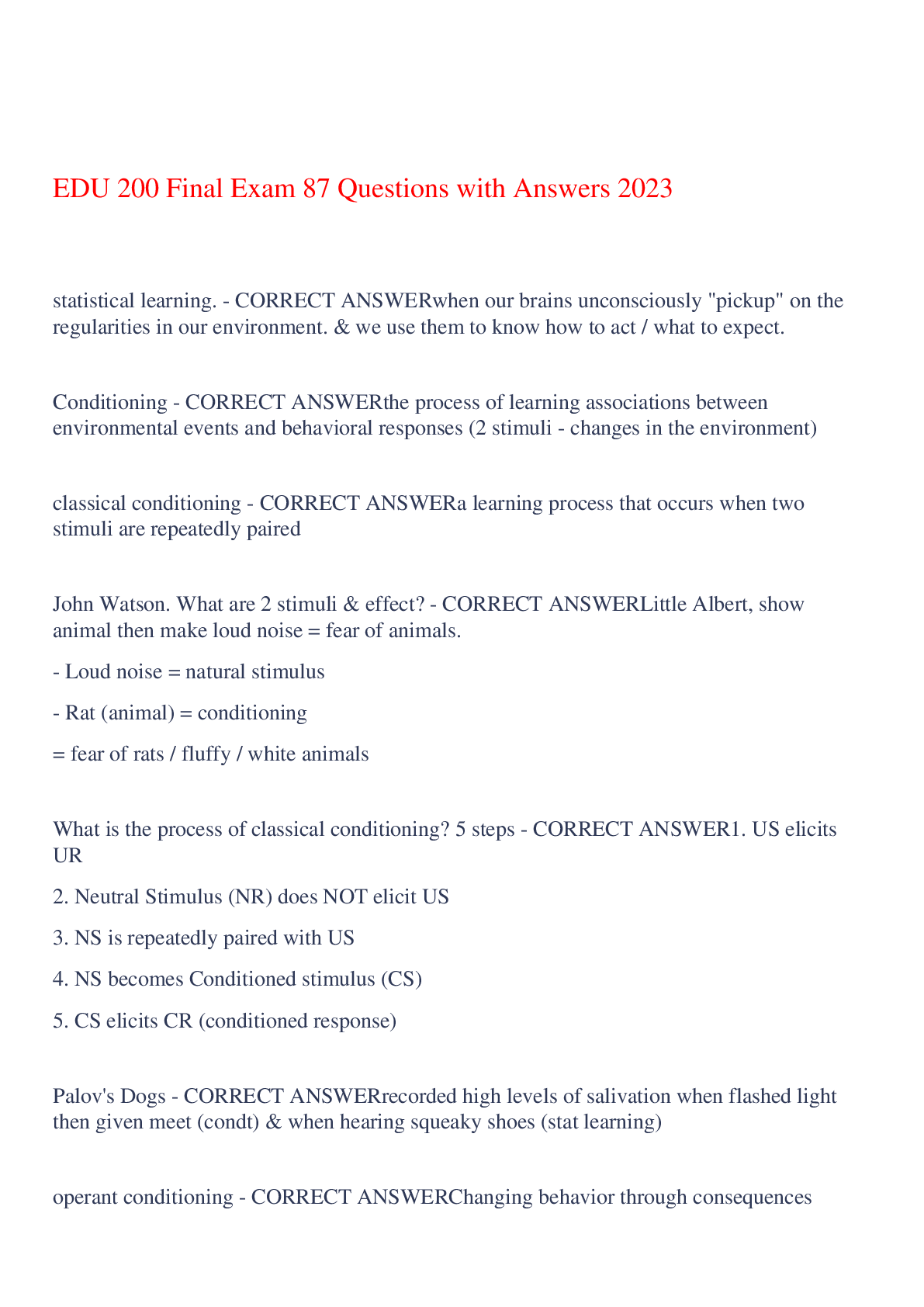
Instant download
Reviews( 0 )
Document information
Connected school, study & course
About the document
Uploaded On
Jun 24, 2023
Number of pages
14
Written in
Additional information
This document has been written for:
Uploaded
Jun 24, 2023
Downloads
0
Views
181



















